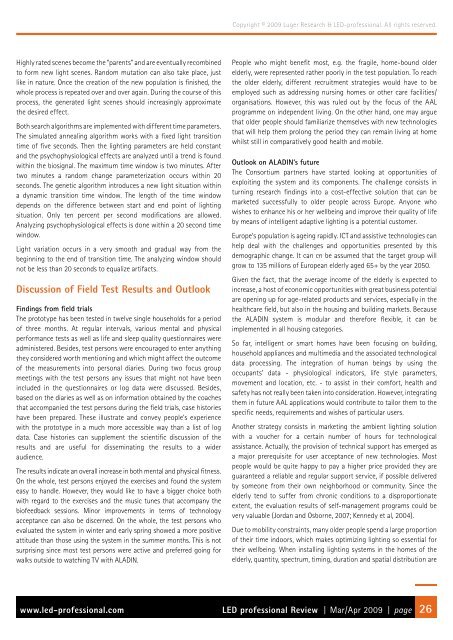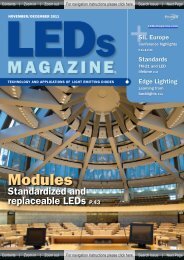LED Applications & Lighting Systems - fonarevka
LED Applications & Lighting Systems - fonarevka
LED Applications & Lighting Systems - fonarevka
You also want an ePaper? Increase the reach of your titles
YUMPU automatically turns print PDFs into web optimized ePapers that Google loves.
Copyright © 2009 Luger Research & <strong>LED</strong>-professional. All rights reserved.<br />
Highly rated scenes become the “parents” and are eventually recombined<br />
to form new light scenes. Random mutation can also take place, just<br />
like in nature. Once the creation of the new population is finished, the<br />
whole process is repeated over and over again. During the course of this<br />
process, the generated light scenes should increasingly approximate<br />
the desired effect.<br />
Both search algorithms are implemented with different time parameters.<br />
The simulated annealing algorithm works with a fixed light transition<br />
time of five seconds. Then the lighting parameters are held constant<br />
and the psychophysiological effects are analyzed until a trend is found<br />
within the biosignal. The maximum time window is two minutes. After<br />
two minutes a random change parameterization occurs within 20<br />
seconds. The genetic algorithm introduces a new light situation within<br />
a dynamic transition time window. The length of the time window<br />
depends on the difference between start and end point of lighting<br />
situation. Only ten percent per second modifications are allowed.<br />
Analyzing psychophysiological effects is done within a 20 second time<br />
window.<br />
Light variation occurs in a very smooth and gradual way from the<br />
beginning to the end of transition time. The analyzing window should<br />
not be less than 20 seconds to equalize artifacts.<br />
Discussion of Field Test Results and Outlook<br />
Findings from field trials<br />
The prototype has been tested in twelve single households for a period<br />
of three months. At regular intervals, various mental and physical<br />
performance tests as well as life and sleep quality questionnaires were<br />
administered. Besides, test persons were encouraged to enter anything<br />
they considered worth mentioning and which might affect the outcome<br />
of the measurements into personal diaries. During two focus group<br />
meetings with the test persons any issues that might not have been<br />
included in the questionnaires or log data were discussed. Besides,<br />
based on the diaries as well as on information obtained by the coaches<br />
that accompanied the test persons during the field trials, case histories<br />
have been prepared. These illustrate and convey people’s experience<br />
with the prototype in a much more accessible way than a list of log<br />
data. Case histories can supplement the scientific discussion of the<br />
results and are useful for disseminating the results to a wider<br />
audience.<br />
The results indicate an overall increase in both mental and physical fitness.<br />
On the whole, test persons enjoyed the exercises and found the system<br />
easy to handle. However, they would like to have a bigger choice both<br />
with regard to the exercises and the music tunes that accompany the<br />
biofeedback sessions. Minor improvements in terms of technology<br />
acceptance can also be discerned. On the whole, the test persons who<br />
evaluated the system in winter and early spring showed a more positive<br />
attitude than those using the system in the summer months. This is not<br />
surprising since most test persons were active and preferred going for<br />
walks outside to watching TV with ALADIN.<br />
People who might benefit most, e.g. the fragile, home-bound older<br />
elderly, were represented rather poorly in the test population. To reach<br />
the older elderly, different recruitment strategies would have to be<br />
employed such as addressing nursing homes or other care facilities/<br />
organisations. However, this was ruled out by the focus of the AAL<br />
programme on independent living. On the other hand, one may argue<br />
that older people should familiarize themselves with new technologies<br />
that will help them prolong the period they can remain living at home<br />
whilst still in comparatively good health and mobile.<br />
Outlook on ALADIN’s future<br />
The Consortium partners have started looking at opportunities of<br />
exploiting the system and its components. The challenge consists in<br />
turning research findings into a cost-effective solution that can be<br />
marketed successfully to older people across Europe. Anyone who<br />
wishes to enhance his or her wellbeing and improve their quality of life<br />
by means of intelligent adaptive lighting is a potential customer.<br />
Europe’s population is ageing rapidly. ICT and assistive technologies can<br />
help deal with the challenges and opportunities presented by this<br />
demographic change. It can cn be assumed that the target group will<br />
grow to 135 millions of European elderly aged 65+ by the year 2050.<br />
Given the fact, that the average income of the elderly is expected to<br />
increase, a host of economic opportunities with great business potential<br />
are opening up for age-related products and services, especially in the<br />
healthcare field, but also in the housing and building markets. Because<br />
the ALADIN system is modular and therefore flexible, it can be<br />
implemented in all housing categories.<br />
So far, intelligent or smart homes have been focusing on building,<br />
household appliances and multimedia and the associated technological<br />
data processing. The integration of human beings by using the<br />
occupants’ data - physiological indicators, life style parameters,<br />
movement and location, etc. - to assist in their comfort, health and<br />
safety has not really been taken into consideration. However, integrating<br />
them in future AAL applications would contribute to tailor them to the<br />
specific needs, requirements and wishes of particular users.<br />
Another strategy consists in marketing the ambient lighting solution<br />
with a voucher for a certain number of hours for technological<br />
assistance. Actually, the provision of technical support has emerged as<br />
a major prerequisite for user acceptance of new technologies. Most<br />
people would be quite happy to pay a higher price provided they are<br />
guaranteed a reliable and regular support service, if possible delivered<br />
by someone from their own neighborhood or community. Since the<br />
elderly tend to suffer from chronic conditions to a disproportionate<br />
extent, the evaluation results of self-management programs could be<br />
very valuable (Jordan and Osborne, 2007; Kennedy et al, 2004).<br />
Due to mobility constraints, many older people spend a large proportion<br />
of their time indoors, which makes optimizing lighting so essential for<br />
their wellbeing. When installing lighting systems in the homes of the<br />
elderly, quantity, spectrum, timing, duration and spatial distribution are<br />
www.led-professional.com <strong>LED</strong> professional Review | Mar/Apr 2009 | page 26

















